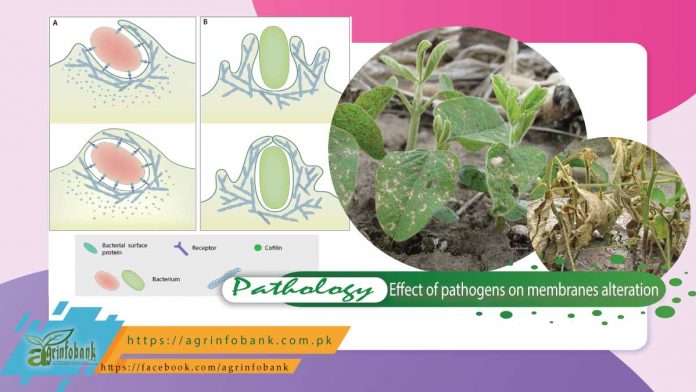Cell membranes consist of a double layer of lipid molecules in which many kinds of protein molecules are embedded, parts of which usually protrude on one or both sides of the lipid bilayer Membranes function as permeability barriers that allow passage into a cell only of substances the cell needs and inhibit passage out of the cell of substances needed by the cell.
The lipid bilayer is impermeable to most biological molecules. Small water-soluble molecules such as ions (charged atoms or electrolytes), sugars, and amino acids flow through or are pumped through special membrane channels made of proteins. In plant cells, because of the cell wall, only small molecules reach the cell membrane. In animal cells and in artificially prepared plant protoplasts, however, large molecules or particles may also reach the cell membrane and enter the cell by endocytosis, in which a patch of the membrane surrounds and forms a vesicle around the material to be taken in, brings it in, and releases it inside the cell.
Disruption or disturbance of the cell membrane by chemical or physical factors alters (usually increases) the permeability of the membrane with a subsequent uncontrollable loss of useful substances, as well as the inability to inhibit the inflow of undesirable substances or excessive amounts of any substances. Changes in cell membrane permeability are often the first detectable responses of cells to infection by pathogens, to most host-specific and several nonspecific toxins, to certain pathogen enzymes, and to certain toxic chemicals, such as air pollutants.
The most commonly observed effect of changes in cell membrane permeability is the loss of electrolytes, of small water-soluble ions and molecules from the cell. Electrolyte leakage occurs much sooner and at a greater rate when the host–pathogen interaction is incompatible, and the host remains more resistant than when the host is susceptible and develops extensive symptoms It is not certain, however, whether the cell membrane is the initial target of pathogen toxins and enzymes and whether the accompanying loss of electrolytes is the initial effect of changes in cell membrane permeability or whether the pathogen products actually affect other organelles or reactions in the cell, in which case cell permeability changes and loss of electrolytes are secondary effects of the initial events.

Hafiz Muhammad Rizwan Mazhar
Department of Plant Pathology, University of Agriculture, Faisalabad-Pakistan
(E-mail: rizwanmazhar084@gmail.com)
If pathogens do, indeed, affect cell membrane permeability directly, it is likely that they bring this about by stimulating certain membrane-bound enzymes, such as ATPase, which are involved in the pumping of H+ in and K+ out through the cell membrane, by interfering with processes required for the maintenance and repair of the fluid film making up the membrane, or by degrading the lipid or protein components of the membrane by pathogenproduced enzymes.Levels of conductivity measuring the leakage of electrolytes released from leaves of pepper plants inoculated with three races of the bacterium Xanthomonas campestris pv. vesicatoria. Release of electrolytes occurred later and at a slower rate when leaves were inoculated with a virulent race of the bacterium.
Disruption of membranes and electrolyte leakage occurred much earlier, and at a much greater rate, when leaves were inoculated with two bacterial races carrying avirulence genes that triggered the hypersensitive response in plants carrying the corresponding resistance genes. Increased electrolyte leakage in numerous host-pathogen combinations has led to the concept that “changes in permeability appear to be universally characteristic of diseased plant tissue regardless of disease type or the nature of the pathogenic agent . A change in membrane permeability is one of the first detectable symptoms. In some studies with toxic pathogen-produced metabolites (phytotoxins) that reproduce disease symptoms of pathogens, e.g., Cochliobolus victoriae toxin (victorin), permeability alterations were found shortly after contact with the host cells was established. It was hypothesized that all subsequent pathological changes may be triggered by this primary event.
Because the plasma membrane is the first site of interaction between invading microorganisms and the plant protoplast, it became obvious that the plasma membrane plays an important role in disease development. This role was suggested to be even more dramatic in the case of host-selective toxins, toxins injurious only to hosts susceptible to the parental fungal species, because the plasma membrane participates in the recognition process . It is becoming more obvious, however, that massive electrolyte leakage may result from general cell injury rather than from the alterations of specific sites at the plasma membrane (e.g., damage caused by oxygen free radical-induced membrane lipid peroxidation.One characteristic feature of many phytopathogenic organisms is their ability to produce an array of enzymes capable of degrading the complex polysaccharides of the plant cell. These enzymes usually are produced inductively.
Generally, they are extracellular, highly stable and present in infected host tissues. In most plant diseases caused by microbial agents, cell walls are penetrated, tissues are colonized, and permeability of host cells is altered. A brief summary of our understanding of cell wall and membrane structure, coupled with knowledge of the enzymes capable of degrading the components of these structures, and an analysis of the association of these enzymes with diseased tissue, should enable us to make an appraisal of their involvement in pathogenesis and point the way to an objective consideration of this area of disease physiology.The phytotoxin, helminthosporal , can damage the permeability of plant cell membranes and it is suggested that this may be an important factor in the susceptibility .


